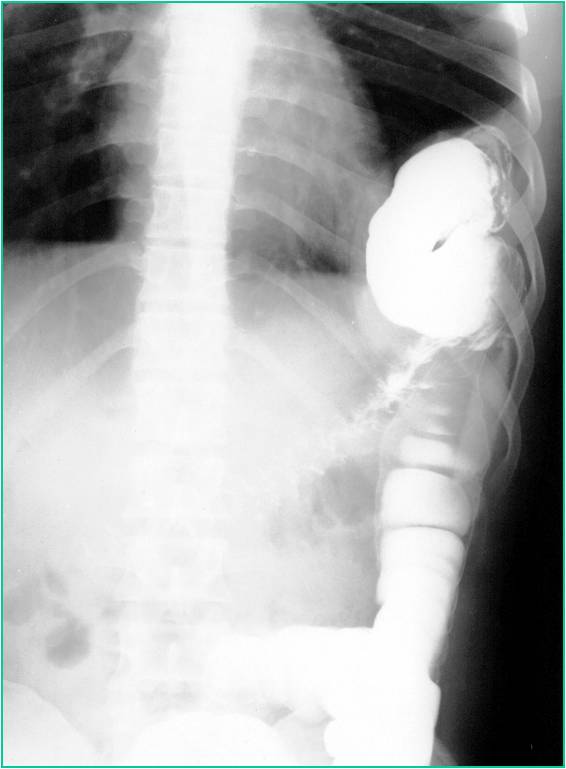
Neonatal Bochdalek hernia. a A 1dayold boy with left Bochdalek... Download Scientific Diagram
Bochdalek hernia is a posterolateral diaphragmatic defect resulting from failure of the retroperitoneal canal membrane to fuse with the dorsal esophageal mesentery and the body wall. The location of the foramina of Bochdalek is defined by the location of the diaphragmatic coronary ligaments bilaterally. The herniation is termed "congenital.
Bochdalek hernia radRounds Radiology Network
Bochdalek hernia is a developmental defect in the posterolateral diaphragm, allowing herniation of abdominal contents into the thorax, causing mechanical compression of the developing lung parenchyma and sometimes causing lung hypoplasia. As such, symptoms typically manifest in the pediatric age group and tend to be respiratory.

Bochdalek hernia Radiology Case Radiology, Radiologic technology, Case
Bochdalek hernias are congenital diaphragmatic hernias resulting from the failure of posterolateral diaphragmatic foramina to fuse properly in utero. 1 First described by Bochdalek in 1848, 2 this entity has been almost purely a pediatric disease that generally presents with pulmonary symptoms between the neonatal period and preschool age. 1 - 5.

Image
OBJECTIVE. The purpose of this study was to determine the prevalence and characteristics of adult Bochdalek's hernia in a large patient population. MATERIALS AND METHODS. We retrospectively reviewed all abdominal CT scans obtained at our hospital in 1998.

Rightsided Bochdalek’s hernia in an adult The American Journal of Surgery
ct CT thorax coronal view demonstrates a right Bochdalek hernia. There is herniation of peritoneal fat through a congenital diaphragmatic defect, Bochdalek foramen, in the posterolateral right hemidiaphragm. Bochdalek hernia is usually left sided and maybe an incidental finding in as high as 10% of asymptomatic adult 1 .

Bochdalek Hernia images, diagnosis, treatment options, answer review Thoracic Imaging
A Bochdalek hernia is a defect of the posterior hemidiaphragm with protrusion of abdominal content, usually fat, into the thorax [1]. It may occur on either side, but is more common on the left side due to a protective barrier effect of the liver [1, 2].

Congenital diaphragmatic herniation (CDH) accounts for a small proportion of all diaphragmatic
Bochdalek hernias , also known as pleuroperitoneal hernias, (alternative plural: herniae) are the commonest type of congenital diaphragmatic hernia. They occur posteriorly and are due to a defect in the posterior attachment of the diaphragm when there is a failure of pleuroperitoneal membrane closure in utero.
Bochdalek hernia radRounds Radiology Network
Presentation Abdominal discomfort, cough Patient Data Age: 20 years Gender: Female ct Defect in posteromedial aspects of right hemi-diaphragm with herniation of large, small bowel and right kidney into thorax. Case Discussion Findings consistent with Bochdalek hernia 3 public playlists include this case Related Radiopaedia articles

Bochdalek Hernia images, diagnosis, treatment options, answer review Thoracic Imaging
Bochdalek hernia is one of two forms of a congenital diaphragmatic hernia, the other form being Morgagni hernia. A Bochdalek hernia is a congenital abnormality in which an opening exists in the infant's diaphragm, allowing normally intra-abdominal organs (particularly the stomach and intestines) to enter into the thoracic cavity.

Bochdalek hernia On conventional radiographs, the hernia may appear as a
Abstract The chest and abdominal computed tomography (CT) scans of 940 patients were reviewed to determine the prevalence of Bochdalek hernias and to evaluate the widely held concept that left-sided hernias occur more than nine times as often as right-sided hernias.

Bochdalek (Pleuroperitoneal) Hernia radRounds Radiology Network
Bochdalek Hernia. More common. Occurs through old pleuroperitoneal canals. Just lateral to the spine on either side. More frequent on left side. Possibly due to "protection" of right-side by liver. Hernia may contain intestine, stomach, spleen, liver or omentum. If hernia occurs on right. Intestine and liver or only liver may herniate.

Bochdalek Hernia images, diagnosis, treatment options, answer review Thoracic Imaging
The Bochdalek hernia was confirmed on computed tomography (CT) imaging and the patient underwent surgical repair with Gore-Tex mesh. Conclusion The report shows a rare case of the Bochdalek hernia in a young adult, successfully managed with a laparotomy.

Symptomatic Bochdalek hernia in an adult patient BMJ Case Reports
Journal of Thoracic Imaging, Vol. 24, No. 1 Prevalence of Incidental Bochdalek's Hernia in a Large Adult Population November 23, 2012 | American Journal of Roentgenology, Vol. 177, No. 2

Bochdalek hernia Radiology Case
Coronal C+ portal. venous phase. Sagittal C+ portal. venous phase. CT scout image reveals indistinct right diaphragmatic copula with right paracardiac soft tissue shadow. CT images show a defect of the right crus of the diaphragm with herniation of the stomach, the first part of the duodenum and part of the left lobe of the liver into the right.

Rightsided Bochdalek’s hernia in an adult The American Journal of Surgery
Presentation Shortness of breath. Patient Data Age: 70 years Gender: Female ct Axial lung window Coronal lung window Axial non-contrast There is herniation of some peritoneal fat through a diaphragmatic defect in the posteromedial aspect of the left hemidiaphragm. Case Discussion

Bochdalek Hernia images, diagnosis, treatment options, answer review Thoracic Imaging
Coronal C+ portal venous phase. Sagittal C+ portal venous phase. CT. CT scout. CT scout image reveals indistinct right diaphragmatic copula with right paracardiac soft tissue shadow. CT images show a defect of the right crus of the diaphragm with herniation of the stomach, the first part of the duodenum and part of the left lobe of the liver.